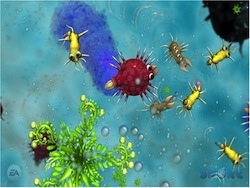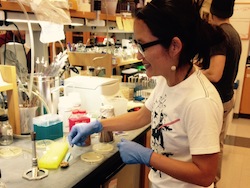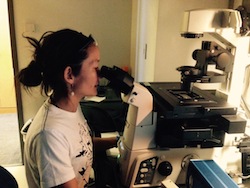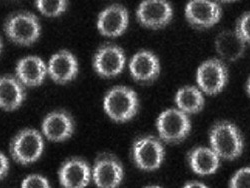Life Cycles
In case you missed reading our last blog post (Gaga for Goo), we recently traveled to Boston to geek out and work with scientist friends at Harvard Medical School to investigate the probiotic nature of our natto. Among the many people we have to thank (below, from left to right): David Rudner/ Dana Boyd & Joe Davis with Ann Yonetani.
Dr. David Rudner and his lab study Bacillus subtilis (the same bacterial species which ferments natto) because of the interesting biology of its life cycle. They are investigating how these bacteria undergo sporulation, a developmental program which allows them to enter a dormant state in the form of a seed-like spore.
Certain species of primitive plants, protozoa, algae, fungi and bacteria can form spores as part of their natural life cycle. Spores are "a unit of asexual reproduction…adapted for dispersal and survival, often for long periods of time, in unfavorable conditions." (2)
Great cartoon/microscopy images of how Bacillus subtilis undergoes the process of sporulation, transitioning from a normally growing bacterial cell (left) through stages of creating a small separate intracellular compartment (second from left) which then becomes engulfed inside the larger cell (third from left), eventually maturing and being released from the dead cell (right) as a dormant and highly indestructible SPORE. Image by David Rudner, HMS (1)
NYrture New York Natto is created by inoculating hot, pressure-steamed, GMO-free, whole soybeans with spores of Bacillus subtilis (var. natto). Triggered by the heat and rich source of nutrients the beans provide, these spores "wake up" or germinate and begin re-entering a growing phase of their life cycle. In David's lab, we were able to use tools of scientific inquiry to observe and measure the probiotic bacteria living inside our natto.
Spores don't really look like they do in the video game SPORE (above, left). Rather, Bacillus subtilis spores typically look like this (right); round structures about 1um in diameter, viewed above by confocal microscopy with a fluorescent membrane-staining dye outlining the spore edges (3). We scooped up some NYrture New York Natto "goo", slapped it on glass slides and had a look….
Screenshot from confocal microscope (phase/DAPI stain) of a direct sample from our natto. Not pretty, but a field of thousands of both dead (lighter) and living (dark with halos) Bacillus subtilis cells in our food. Biologists may notice that living cells of different lengths are seen, indicating that these cells are at various stages of their vegetative life cycle, actively growing & dividing.
We were super excited to see so very many live Bacillus subtilis both actively growing and undergoing sporulation inside our food! This is significant because the vast majority of bacteria (beneficial or not) taken in through food are destroyed during (food storage and) digestion by the extremely acidic stomach environment and/or anaerobic conditions in the gut. This calls into serious question the actual utility of most probiotic foods/products out there.
But further, under the microscope it looked like at least some of these living cells in our natto were also undergoing sporulation! This was intriguing because if our natto also contains fresh spores (which are nearly indestructible and therefore resistant to digestive assault), these spores are certain to be able to reach the gut where they can germinate and effectively colonize and grow, contributing to human gut health! So, here's what we did to find out...
This (above) petri plate shows a series of serial dilutions of natto "goo" taken directly from a jar of month-old NYrture New York Natto spotted in dots across a line on the agar media near the top edge of the dish; then the plate was held on its side to allow each dilution sample spot of liquid to drip by gravity downwards to form straight lines streaking down the agar surface before being let to grow overnight in a warm incubator. Starting from the left, a 1:1 dilution of natto "goo", followed by serial 10x dilutions (10x, 100x, 1000x, etc…) of the first, left-hand sample. By diluting the sample down enough orders of magnitude, one can pretty accurately estimate the number of individual cells present in the original sample from the number of colonies (visible spots of cells) that appear the next day. From this, Alex Meeske in the Rudner lab, gave us an approximation of ~15 million live Bacillus subtilis cells in each milliliter of NYrture natto "goo"(4).
But now we wanted to know IF and HOW MANY of these cells/colonies came from SPORES also present in the natto "goo"? Here, we can take advantage of the fact that spores are so hardy and resistant to heat by boiling each of the samples for twenty minutes! No bacterial cells can survive this hot tub, but spores can! So what do we see if we plate the boiled, heat-killed samples in the same manner as above?
We saw that some Bacillus subtilis cells DID GROW from spores present in the boiled, heat-killed samples! By comparing the number of colonies in this streak (coming from the most concentrated left sample) to those on the previous (unheated samples) plate, we see that it is close to that of the third (100x) dilution. Therefore, we can guestimate that ~1% of the Bacillus subtilis growing from our natto are derived from spores in the food. This translates to about 1.5 million spores per milliliter of natto "goo"! (4)
Summary: We found that our NYrture natto contained at least ~15 million live Bacillus subtilis bacteria and ~1.5 million viable Bacillus subtilis spores per milliliter. In eating terms, a generous serving of 50mls contains 750 million cells and 75 million viable spores of probiotic bacteria! Noting that these results came from a month-old jar of our natto, the numbers may be even higher for a fresher batch! Truly, we could not be more pleased with these results, and we're certain that our fresh natto contains far more viable probiotic bacteria than any other (frozen) natto available here!
References: (1) http://micro.med.harvard.edu/faculty/rudnergraphic-lg.jpg (2) Wikipedia [spore]: https://en.wikipedia.org/wiki/Spore. (3) Cowan, A. E. et al. PNAS.101:20, 7733-8. (4) personal communication from Dr. Alex Meeske, Rudner lab, Harvard Medical School, now Maraffini lab, Rockefeller University.










